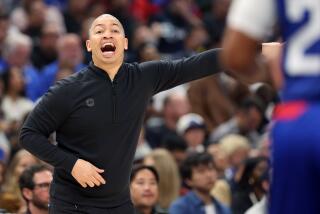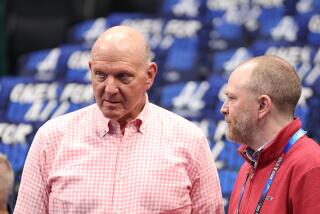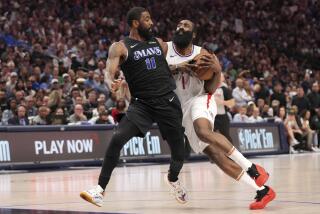Clippers Doing Same Old Dot Con
- Share via
... They’ll start training camp next week in much the same manner they started the summer, with the long-term status of the franchise up in the air, unresolved, to be continued....
Every step forward also brings them a step closer to the abyss. On Monday the Clippers proceeded with the formality of signing center Michael Olowokandi to a one-year tender offer of $6.1 million. That means they missed a chance to sign him to a long-term contract, and he’ll become an unrestricted free agent next year.
Also, a team official added to the growing feeling that Elton Brand won’t sign a contract extension before the Oct. 31 deadline.
“It’s very possible that we will put off that issue until next summer,” Clipper Vice President Andy Roeser said.
It’s not as if this off-season has been a waste. The Clippers completed what Roeser called a “massive upgrade” of the point guard position by trading for Andre Miller and signing Yugoslavian Marko Jaric, a 2000 draft pick.
But they didn’t progress in making the major financial statement we’ve been waiting to see, the big put-up that would make everyone shut up.
They’re willing to go with the status quo for another year, with the understanding that great individual seasons could raise the asking prices.
And that’s what they’re risking--individual seasons. With Olowokandi, Brand, Miller, Lamar Odom, Corey Maggette, Eric Piatkowski, Quentin Richardson, Keyon Dooling and Sean Rooks eligible for some type of contract discussions next year, you could be looking at a different agenda for practically every player stepping on the court. How would you like to be Alvin Gentry, with some player’s agent calling to complain each time the coach took someone out of the game?
The safest way to take at least some of the edge off this season would have been to sign Brand. One source said Brand would have taken less than max money to stay with the Clippers. If a $70-million offer could have sealed it, it should already be done.
There’s little downside. He’s going to average 19 points and 10 rebounds, he’s going to stay out of trouble. And by signing him, Donald Sterling could have pressed the mute button on all of those who say he’ll never commit the serious paper.
Wouldn’t a little peace and quiet be worth it?
Instead, we hear a lot of the same noise--including the same promises from the Clippers, which have yet to come with a money-backed guarantee.
“We will do what we have to do to keep this nucleus together,” Roeser said. “Next summer we will reward all our players consistent to their contributions to our team’s success this season.”
Technically, the Clippers still have the capability of bringing everyone on this team back for at least one more season after this one. That’s not the realistic expectation. As one observer said of Olowokandi’s future in L.A.: “This is it and they know it.”
Those weren’t the terms Olowokandi’s agent used.
“It keeps Michael in a situation that we’re currently comfortable with,” Bill Duffy said of the one-year contract.
“His objective is to win and to continue to improve. He understands that and accepts that. In this business, at some point the team has choices and at later points the player has choices.”
Negotiations on a long-term deal weren’t acrimonious, but the sides were far apart.
“I kept making reference to Mike Bibby’s contract,” said Duffy, referring to the seven-year, $80.5-million deal Bibby signed with the Kings. “I don’t think they saw Michael at that level.”
The Clipper numbers would have topped out at an average salary $8.5 million (if all incentives were reached) per year, while Duffy wanted a deal more like $11.5 million per year.
I believe $60 million in guaranteed money would have been more than fair for a guy who’s never played in the All-Star game. But I’ve heard the Clippers didn’t even get to that number.
If Olowokandi delivers on the promise he showed last season and starts playing his way out of the Clippers’ price range, they can’t get a return on his improved stock because players can’t be traded in the midst of a one-year contract. So they’ll either pay up or lose him as a free agent.
We could have a repeat of that scenario next year with Brand, Odom, Miller and Maggette, the members of the 1999 draft class. They’ll become restricted free agents after the season, giving the Clippers the option to match any offer they receive elsewhere, sign them to a long-term deal or offer them a one-year contract at a 30% raise.
This was a bad year to be a free agent, because the salary cap actually dropped, to $40.271 million. It is expected to stay around the same next year, and the luxury tax threshold--the point at which teams have to pay a dollar-for-dollar penalty if they exceed it--should be around $52.5 million.
More teams should have salary cap space available, however, as some of the big contracts from the free-spending summer of 1996 finally terminate.
Where does that leave the Clippers?
“It’s only Chapter 5 of a 10-chapter book,” Duffy said. “They’ve got to deal with that.”
He had a suggestion for how to finish this chapter.
“The periods ... what’s it called?”
Ellipsis.
“Yeah, ellipsis.”
...
J.A. Adande can be reached at [email protected].
More to Read
Get our high school sports newsletter
Prep Rally is devoted to the SoCal high school sports experience, bringing you scores, stories and a behind-the-scenes look at what makes prep sports so popular.
You may occasionally receive promotional content from the Los Angeles Times.






